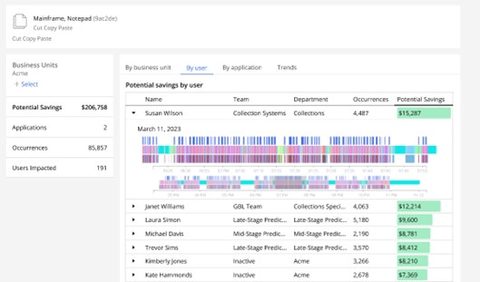One of the most-asked questions I receive is: “What is the difference between Process and Task Mining?” I get the feeling that people think the two are mutually exclusive. While they both solve specific problems when used alone, they are much better when used together — just like peanut butter and jam.
The best way to think about the two together is that Process Mining lets you go wide across your enterprise and see an entire process from start to finish, while Task Mining allows you to dive deep on specific activities in a process to get the perspective of the employee and improve the way they work. Before I dive into a specific example, let’s talk about what Process and Task Mining are and what problems they solve.

What are Process and Task Mining?
Process mining is a practice that takes the logs from enterprise systems and tells you how your processes are really being executed — not how you think they are executed. By mining these existing logs, you can ask questions of your data like “Which transitions take the most time and cause bottlenecks?” or “Where do I have rework loops in my process?” From here, you can make real improvements to your business by redesigning the process, creating automations, or even introducing tools like Process AI to make decisions. Process Mining can also be used to ensure process compliance to avoid risk from missed steps or errors when a process is regulated.
Often, there are activities in a process that are executed by employees before moving to the next step in the process, and these activities occur outside of the enterprise systems and are not captured in the logs. In a study we conducted in 2018, we found that only 28% of an employee’s time is spent in structured applications. Working in unstructured applications leads to 50% more errors, longer processing times, and rework. In fact, we found that each day an employee uses up to 35 applications and swivels between these applications 1,100 times. This is where Task Mining helps by providing visibility into how employees are getting their work completed.
Task Mining lets organizations see how work is getting completed on the desktop from the employee’s perspective. By using a client on the desktop to generate event logs, you can quickly gain insights into the challenges that employees face every day in getting work done. For example, Task Mining lets one see where the employee must copy and paste data between two systems that are not integrated. Also, one is enabled to uncover screens that require significant manual data entry and scrolling. Task mining empowers organizations to see the unseen and improve employees’ lives at work by pinpointing where you should create automations, integrate systems, improve the user experience, and retire old technologies.
Start building for change by using process and task mining
Here is an example from one of our clients that shows the power of using Process and Task Mining together. In this example, we have imported the event logs from the Account Update process in Pega Customer Service™ into Pega Process Mining for analysis. Quickly, we see there is a slow transition in the account details update activity.

Since we have been collecting task data from the team that processes these updates, we can open Opportunity Finder to see if we have any potential automations to fix the issue. The AI-driven insights in Opportunity Finder supply us with a prioritized list of automations based on potential impact. From here we can see that we have copy and paste happening with our mainframe application.

When we drill further into the opportunity, we can see one employee’s daily experience. Each of the blue marks on the screenshot show each time where Susan had to copy and paste data out of mainframe and into notepad. She is having to do this because we have yet to integrate the mainframe into Pega Customer Service.

Before we request the automation, though, let us look at the task details to get more details about the Account Details Update task. From this page, we can see that this month, the swivel out of Pega Customer Service has happened over 163,000 times, affects 822 employees, and takes 1 minute and 22 seconds to complete, which is the equivalent of 23 full time employees. Additionally, every time someone swivels, they are copying and pasting data. Not only is this a lot of time spent moving data between systems, but it also introduces errors in data entry and inconsistencies in process execution.

With the information learned from this analysis of both the process and the underlying tasks, we can now focus our improvements on areas that not only reduce costs, but also make the lives of our employees better.

Since your business is always changing, Process and Task Mining is not a one and done sampling activity. You should always be mining your business and have Process and Task Mining part of your continuous improvement strategy. By doing so, you will make impactful change and accelerate your roadmap to the Autonomous Enterprise.
Want to learn more about how to mine your business? Please contact me at [email protected].

